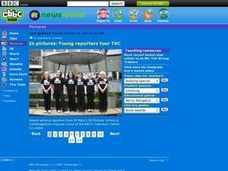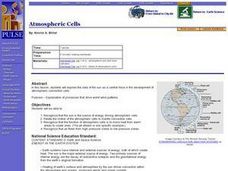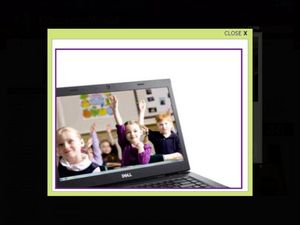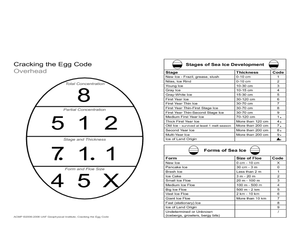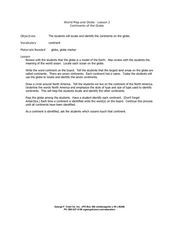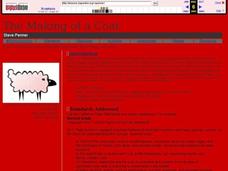Curated OER
Whale of a Tale
Students apply problem solving techniques to answer a question. After reading a passage, they compare and contrast three species of whale in a quantitative fashion.
Curated OER
In pictures: Young reporters tour TVC
Students view a wide range of young reporters and their accomplishments. They view all the places they toured and then analyze one particular place in pictures. Students create a portfolio out of their pictures for view.
Curated OER
Atmospheric Cells
Students recognize that the sun is the source of energy driving atmosphere cells. They relate the motion of the atmospheric cells to mantle convection cells. Students recognize that the function of atmospheric cells is to move heat from...
Curated OER
Exploring the Night Sky: Fall/Winter
Students explain how moon phases occur. They explain three ways that the night sky has been used through history. Students locate some of the constellations in the night sky. They discuss stories and myths surrounding stars.
Curated OER
Frozen Film
Students discover how light reflects off surfaces. In this hands-on demonstration, students examine how variations in color are produced by light interference.
Curated OER
Rising Air
Students investigate the concept of rising air in the formation of clouds and precipitation. In this rising air instructional activity, students conduct an experiment with hot and cold water that shows how warm water rises due to thermal...
Curated OER
Air and Water in the Environment
Second graders participate in a three part lesson in which they identify and describe forms of moisture in the environment. Part one of the lesson involves the three stages of the water cycle, part two focuses on creating humidity by...
Curated OER
Water Cycle Adventure
Students take an imaginary journey through the water cycle. In this water cycle lesson, students identify the various parts of the water cycle, listen while their teacher leads them on an imaginary journey through the water cycle, and...
Curated OER
Ocean Power
Students explore the energy resources of the ocean. In this energy lesson, students participate in 4 activities focused on energy resources from the ocean.
Curated OER
How Islands Form
Students how islands form, rising water levels, growth of coral, and volcanoes. They complete Island Investigation worksheets after researching island formation on various Internet websites.
Curated OER
Earth and Space Science: Exploring Earthquakes
Young scholars explore earthquakes. In this earthquake lesson, students research earthquakes and identify where they take place. Young scholars use map skills to track down earthquake locations. There are internet sites suggested in this...
Curated OER
Memorable Maps
Students draw an assigned map from memory about the United States or any other region they are studying. In this maps lesson plan, students draw a map from their memory at the beginning of the year, and do the same assignment at the end...
Curated OER
Ecosystems: What Are They and How Do They Work?
Learners explore the characteristics of major ecosystems, the interactions of the organisms within the systems, and the effects of humans on the system. Both living and non-living components are examined in this five instructional...
Curated OER
Sea Ice: Cracking the Egg Code
Pupils study the egg code to learn about sea ice. In this sea ice instructional activity, students discuss and view a diagram to learn about the egg code when describing sea ice and its thickness. Pupils work in groups to play a game...
Curated OER
Sea Connections
Students, after locating different marine habitats on a globe, play a card game about ecosystems, food webs and organisms.
Curated OER
Earth: The Apple of our Eye
Students are led through a demonstration in which they cut open an apple, which represents the earth. They follow through the hands-on activity, cutting the apple into various portions--each representing some aspect of the earth.
Curated OER
The Science Behind Dolphins
Students discover facts about marine mammals, specifically dolphins. In this K-2 lesson plan, students identify the different species of Cetaceans, focusing on dolphins. Students answer true/false questions regarding cetaceans and...
Curated OER
Continents of the Globe
Pupils identify the continents on the globe. In this map skills lesson, students define the term "continent" and identify the seven continents on the globe.
Curated OER
The Making of a Coat
Pupils read the story A New Coat For Anna and discuss their knowledge on how to make a coat. In this reading and coat making lesson plan, students discuss coat making and listen to a speaker that spins thread to make coats.
Curated OER
Understanding a Geological Map
Students identify different types of maps and observe a geological map. In this geology lesson students create a replica map of a geological area that includes a key.
Curated OER
Lights On ! Lights Off! Exploring Human Settlement Patterns
Third graders write informational paragraphs based on the settlement patterns of the United States. In this settlement lesson plan, 3rd graders read about population and how it affects where people settle next.
Curated OER
Paper Mache Globes
Third graders create a paper mache model of the earth. At the conclusion of a discussion about the earth, they are given paper mache materials, they create their globe and appropriately draw and label landforms, bodies of water and the...
Curated OER
Taking Care of Nature (Religious)
Students discover how they can help care for the earth. In this environmental protection lesson plan, students discuss how God created the earth and what will happen if they fail to care for the earth properly. Students grow their own...
Curated OER
Observing Sea Ice
Students study and observe types of sea ice found in Alaska. In this sea ice lesson, students use the student network for observing weather to study the different types of sea ice. Students study sea ice depicted in Alaskan art.

